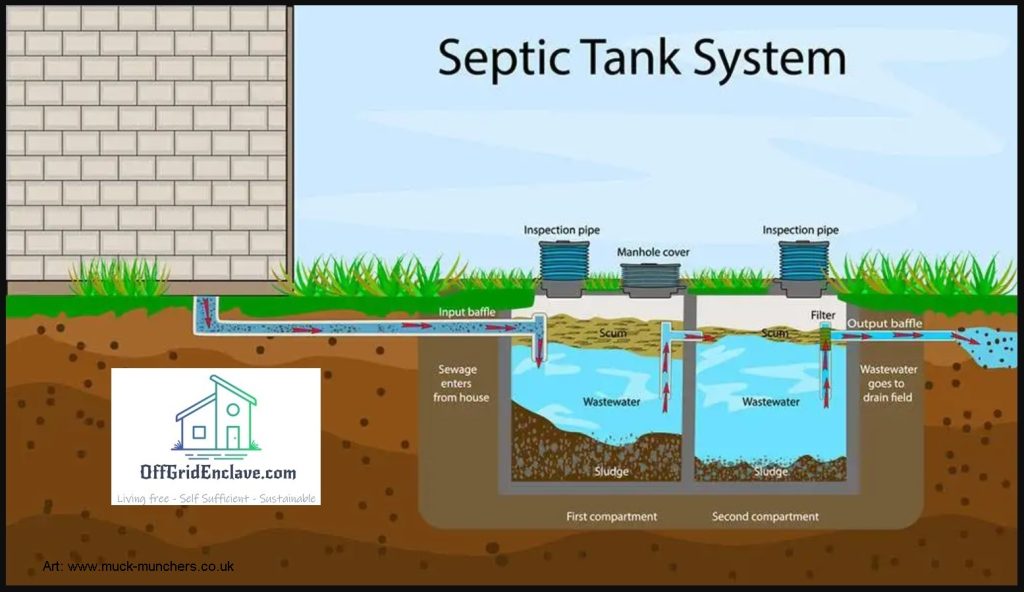
Eaux usées –
Wastewater
The term sewage is nowadays regarded as an older term and is being more and more replaced by “wastewater”.
The distinction between faecal-containing black water and faecal-free grey water is of great importance. The decisive factor is always the type of waste water. Faecal-free wastewater contains water such as shower water or the sewage from washing machines. Waste water containing faecal matter is always present when pipelines are connected that transport faeces from urinals or toilets. The waste water generated on your plot should be discharged in separation system. This means that dirt and rainwater have two different drainage systems. The pipes should preferably have a diameter of 125mm in order to avoid clogging by too small pipes. For the same reason, the angle should be between 0.5% et 2.0%.
Organic pollutants and nutrients
Sewage is a complex mixture of chemicals, with many distinctive chemical characteristics. These include high concentrations of ammonium, nitrate, azote, phosphore, high conductivity (due to high dissolved solids), high alkalinity, with pH typically ranging between 7 et 8. Sewage also contains organic matter that can cause odor and attract flies.
All categories of sewage are likely to carry pathogenic organisms that can transmit disease to humans and animals. Sewage contains human feces, and therefore often contains pathogens.
Onsite sewage facility / Septic Tank System
Read our Septic Tank System Project for more details.
The primary mechanism of biological waste recycling in the natural environment is performed by other organisms such as animals, insects, soil microorganisms, plants, and fungi, which consume all available nutrients in the waste, leaving behind fully decomposed solids that become part of topsoil, and pure drinking water that has been stripped of everything that can possibly be consumed and utilized. This natural biological purification requires time and space to process wastes.

In virtually all engineered onsite sewage facilities, recycling and decomposition by natural organisms is still the primary mechanism of sewage disposal. Giving the organisms the time they need to decompose wastes is accomplished by establishing minimum sewage retention and settling times, and minimum liquid flow distances between sewage disposal sites and surface water or water wells.
A septic tank and drainfield combination is a fairly common type of on-site sewage facility in the Western world.

Onsite sewage facilities may also be based on small-scale aerobic and biofilter units, membrane bioreactors or sequencing batch reactors. These can be thought of as scaled down versions of municipal sewage treatment plants, and are also known as “package plants.”
Vermicomposting Toilets
Un simple, éprouvé, approche low-tech et open source pour une élimination écologique des déchets humains
Read the full build Project.

The design and construction of this vermicomposting toilet system is very simple. Il ne nécessite aucun apport d'énergie externe ni aucune machinerie pour traiter les eaux usées.. There are two main parts to the system (apart from the flush toilet): an insulated tank which houses the worms with their associated ecosystem, and a ‘green-filter’ or soak away area to allow the vermifiltered water to be cleaned further and returned to the environment. This simplicity allows for a lot of flexibility in how the system is implemented to adapt to individual sites.
Seepage Pit
When building a seepage pit, care must be taken to ensure that it is sufficiently dimensioned.
The seepage pit has several tasks. On the main side it is an independent drainage device suitable for the reception of feces or waste water.
In many countries, seepage pits are being built and providing excellent services.
Particularly in rural areas, the seepage pit construction still has a high priority, because the connection to the sewerage system is often expensive and not always possible.
If you want to build seepage pits, the grey waste water can also be integrated. Then the seepage pit resembles a toilet – which can however, stink. The feces are then often fed directly or via piping systems into the built seepage pit. It is important that the subsoil is porous when building the seepage pit, so that liquids can seep into the soil. All that remains are the solids in the seepage pit. The great advantage of building a seepage pit is that a seepage pit is often filled after some time. When it is filled to a certain extent earth is then filled into the seepage pit and finished. When the time comes, you have to build a new seepage pit and excavate a new pit.
Always talk to your expert of choice or ask a friends , par exemple, who have also built a seepage pit.
– Links –
https://en.wikipedia.org/wiki/Sewage
https://en.wikipedia.org/wiki/Onsite_sewage_facility
https://en.wikipedia.org/wiki/Septic_drain_field
https://en.wikipedia.org/wiki/Decentralized_wastewater_system
http://www.vermicompostingtoilets.net/design-construction/